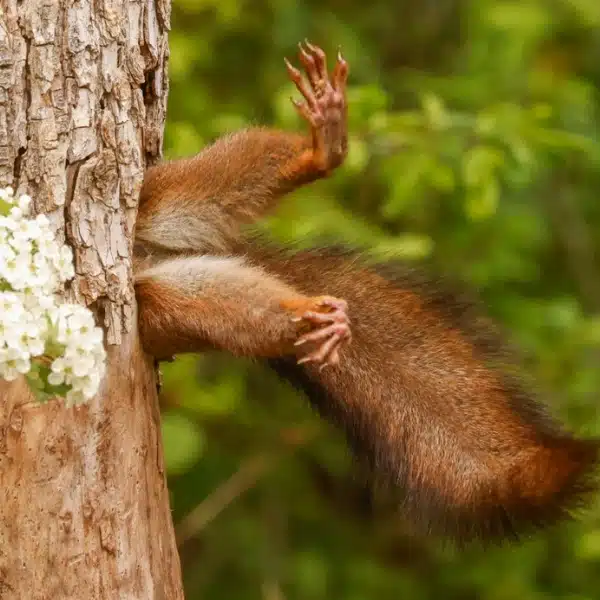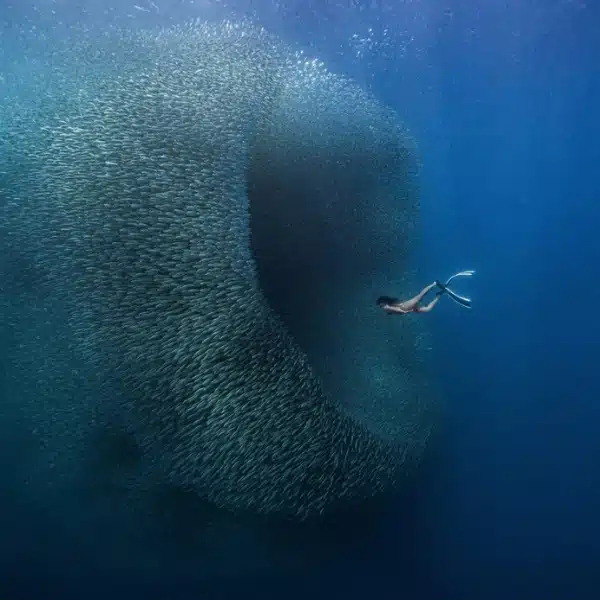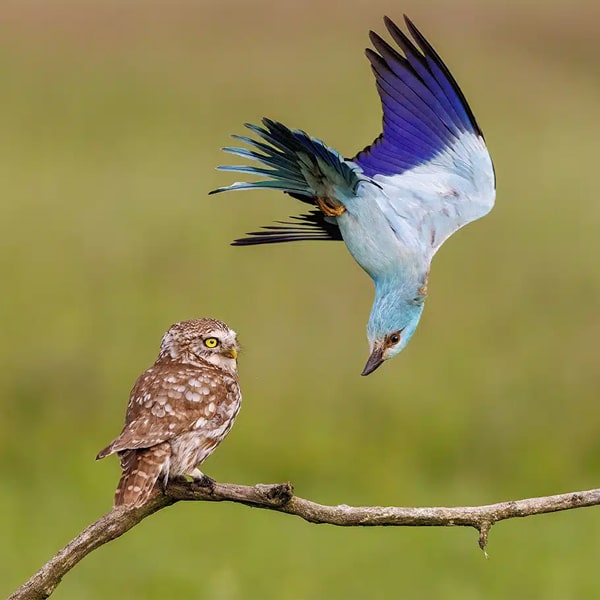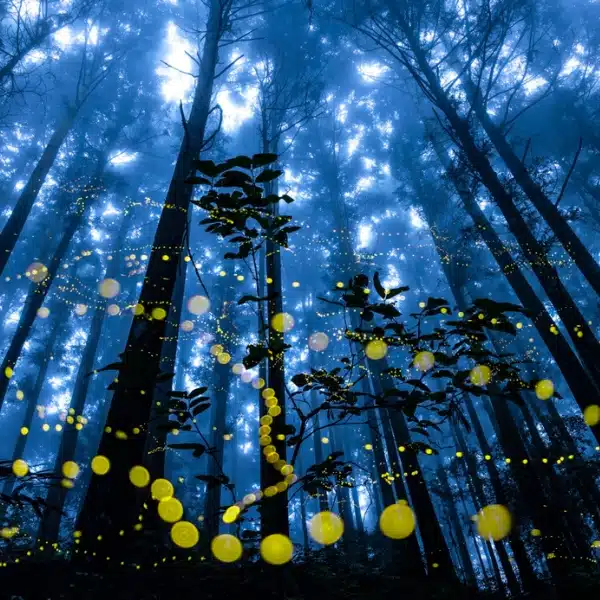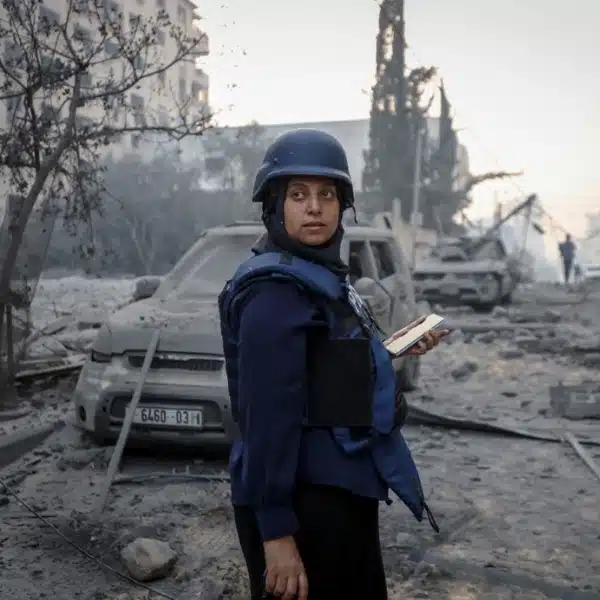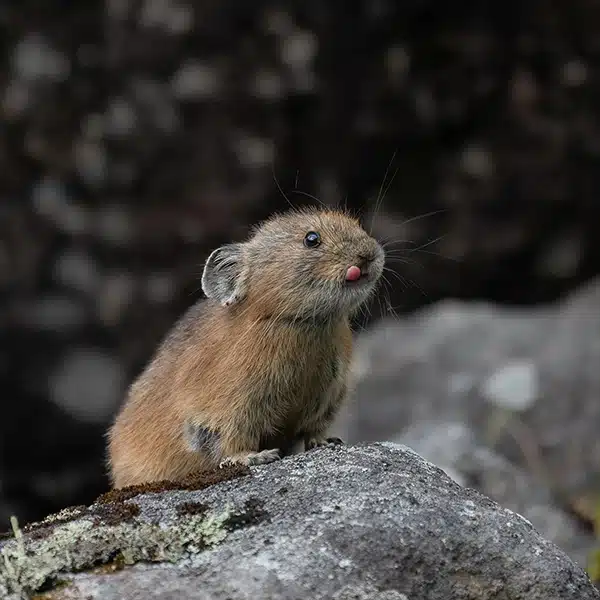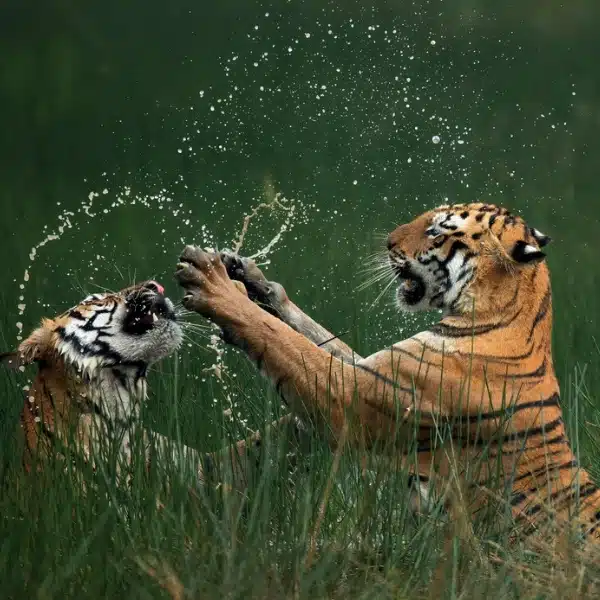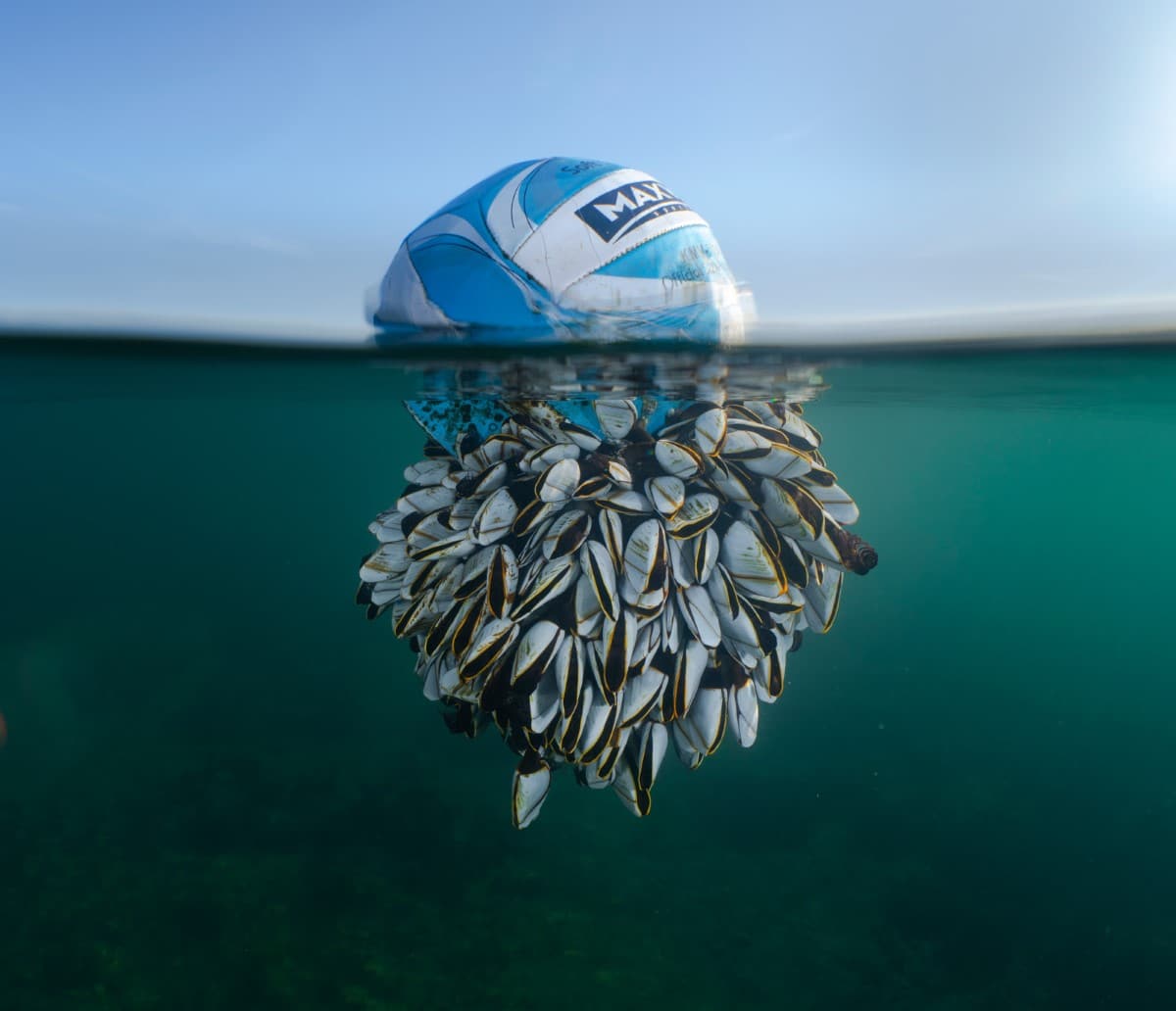
“Ocean Drifter” by Ryan Stalker. British Wildlife Photographer of the Year 2024 and Winner of Coast & Marine
Species: Goose barnacles (Thoracica) Location: Portland, Dorset, England
“Ocean Drifter is a photo of a football that is covered in goose barnacles below the waterline. Above the water is just a football. But below the waterline is a colony of creatures. The football was washed up in Dorset after making a huge ocean journey across the Atlantic and then returned to the sea for the photo to be taken. Goose barnacles are not native to the UK but can wash up on our shores during powerful Atlantic storms. Although the ball is waste, and should not be in the sea, I do wonder about the journey the ball has been on. From initially being lost, then spending time in the tropics where the barnacles are native and perhaps years in the open ocean before arriving in Dorset. However, this waste can also bring creatures that may survive in UK waters and could become invasive species. More human waste in the sea could increase the risk of more creatures making it to our shores.”
After evaluating over 14,000 images, the 2024 British Wildlife Photography Awards deemed Ryan Stalker‘s photograph of a soccer ball adrift in the ocean the winner. But this is no ordinary soccer ball. Having washed up in Dorset after a journey across the Atlantic, it also transported barnacles that clung to the plastic.
Stalker's stunning photo provokes thoughts about how ocean waste can transport invasive living organisms from one place to another. For his masterful photo, which is technically sound and also tells an important story, Stalker took home the title of British Wildlife Photographer of the Year.
In the youth competition, Max Wood was named RSPB Young British Wildlife Photographer of the Year. His evocative photo of a coot running across a misty lake at sunrise is a wonderful showcase of his talent. Wood won the overall prize after being named the top photographer in the 15- to 17-year-old division. In doing so, he beat out young photographers in the 11 and Under and 12-14 years division.
No matter what the age, the overall and category winners have all done an incredible job of showcasing nature in Britain. And in doing so, they provide a crucial reminder of what value the UK's woodlands, wetlands, and other ecosystems still hold.
Scroll down to see all the winners of the 2024 contest, and then get ready for the 2025 awards, which is now accepting entries from photographers of all levels.
Here are the winners of the 2024 British Wildlife Photography Awards.
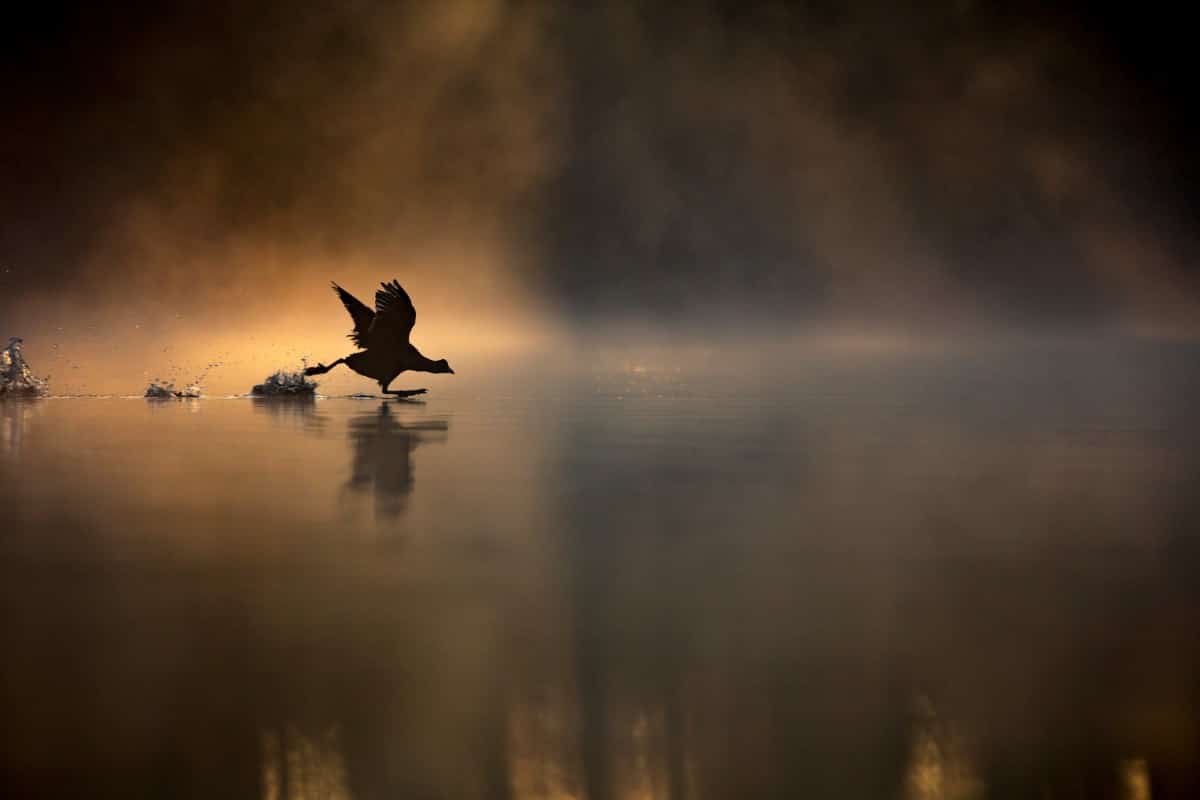
“Running on Water” by Max Wood. RSPB Young British Wildlife Photographer of the Year 2023 and Winner, 15-17 Years
Species: Coot (Fulica atra) Location: Frensham Little Pond, Surrey, England
“I woke up at 4:45 am with the hope of capturing backlit waterfowl images at Frensham Pond in Surrey. I lay down at the edge of the pond and waited for the birds to become active. As the morning progressed, rays of sunlight began to shine through trees along the edge of the pond, creating spotlights in the morning mist. This created a beautiful atmosphere, which I aimed to capture in my images. This coot was fleeing a fight, running across the water to take flight through the mist and rays of light.”
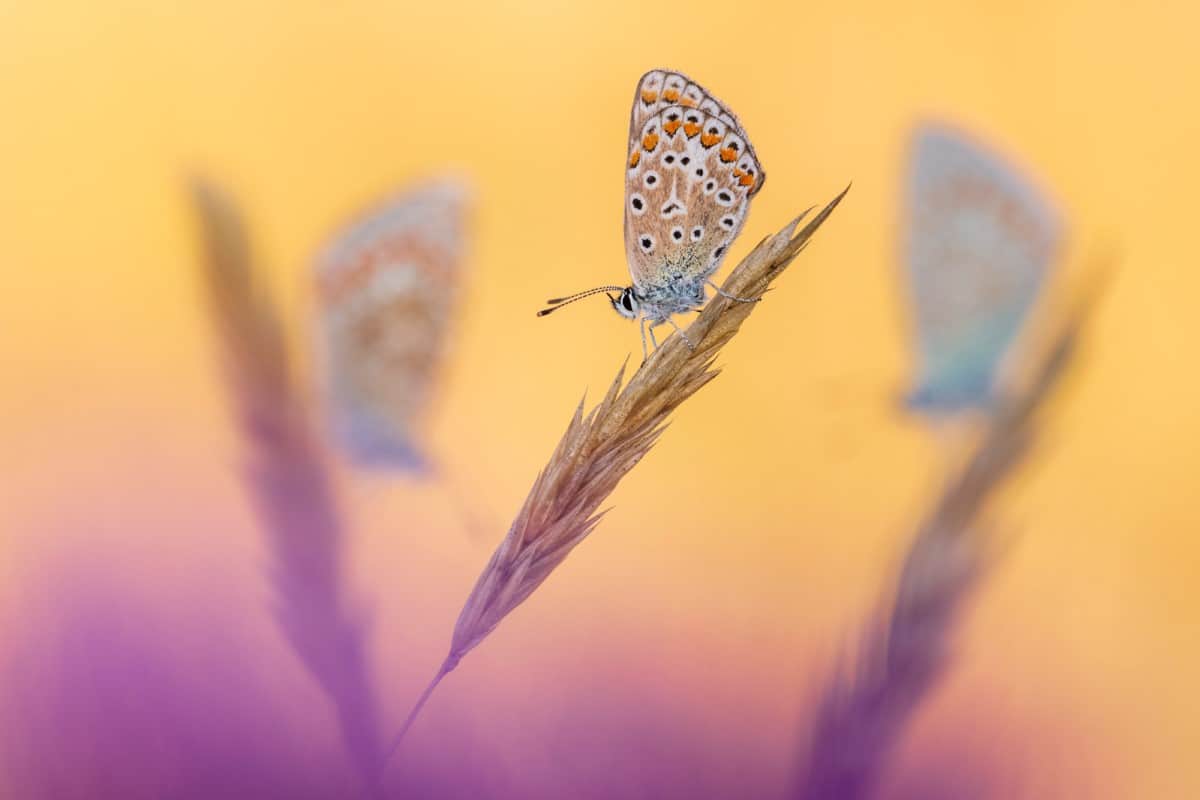
“Three’s a Crowd” by Ross Hoddinott. Winner, Hidden Britain
Species: Common blue butterflies (Polyommatus icarus) Location: Vealand Farm, Devon, England
“I think I have a slight addiction to photographing blue butterflies – I just love them! They are such beautiful little insects, and they enhance any wildflower meadow or garden they inhabit. Blues are quite social insects, and they can often be found roosting quite close together – or even on the same grass or flower. I found a dozen or so blues all resting close together one evening last summer. Using a shallow depth of field, I decided to ‘frame’ my subject with two out-of-focus butterflies to help add impact and context to my shot. The warm, evening light produced a vibrant natural background.”
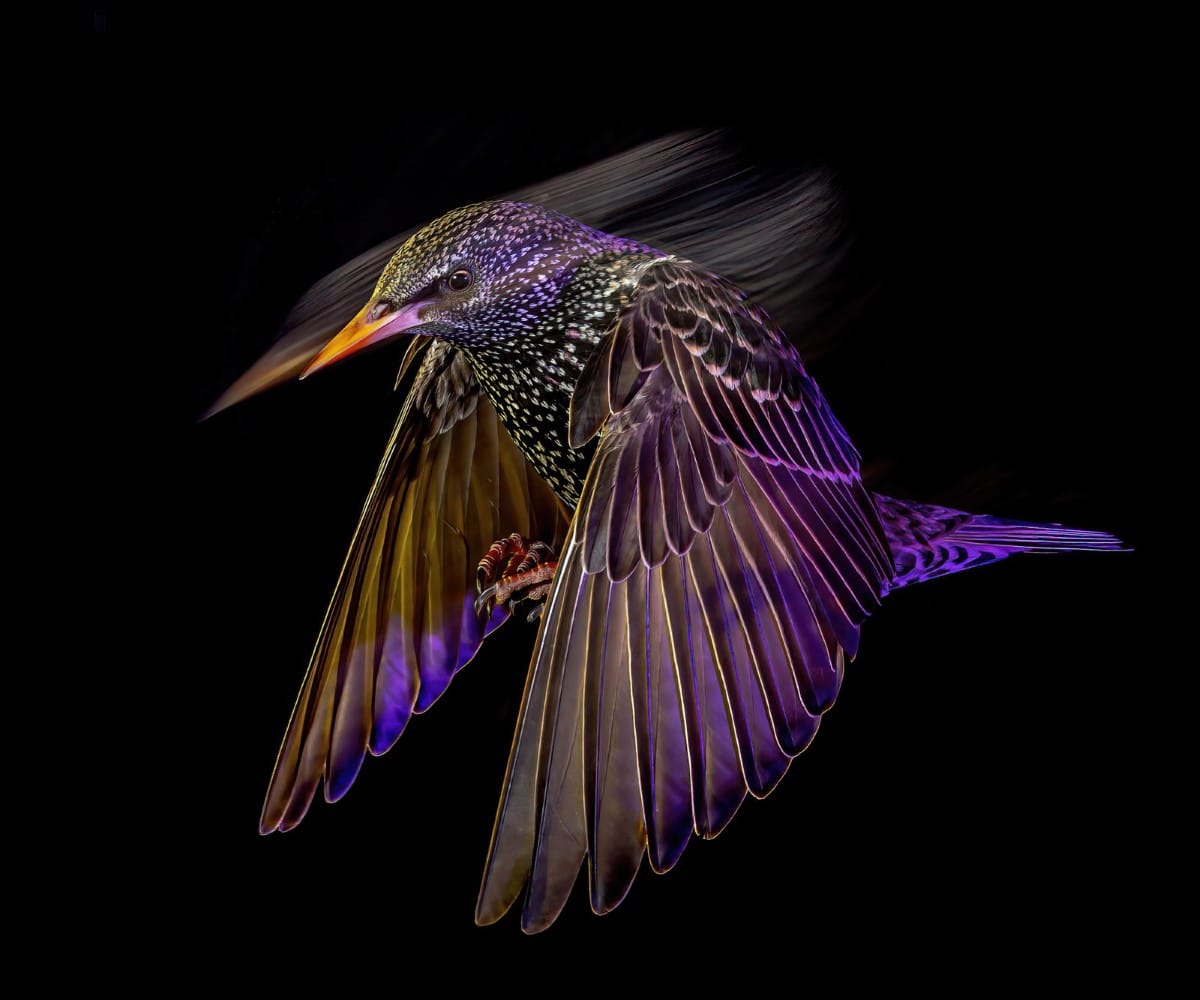
“Starling at Night” by Mark Williams. Winner, Animal Portraits
Species: Common starling (Sturnus vulgaris) Location: Garden, Solihull, West Midlands, England
“I had been observing the birds in my garden as they fed on sunflower seeds and peanuts from the feeder for some time. I aimed to capture the sense of movement and flight patterns in my images while still preserving the fine details of the birds. To achieve this, I used flash in rear curtain sync mode. Timing was crucial, and I needed to carefully balance the flash with the ambient light to record the starling’s trail at the beginning of the exposure, while a brief burst of flash would freeze the bird in mid-flight.”
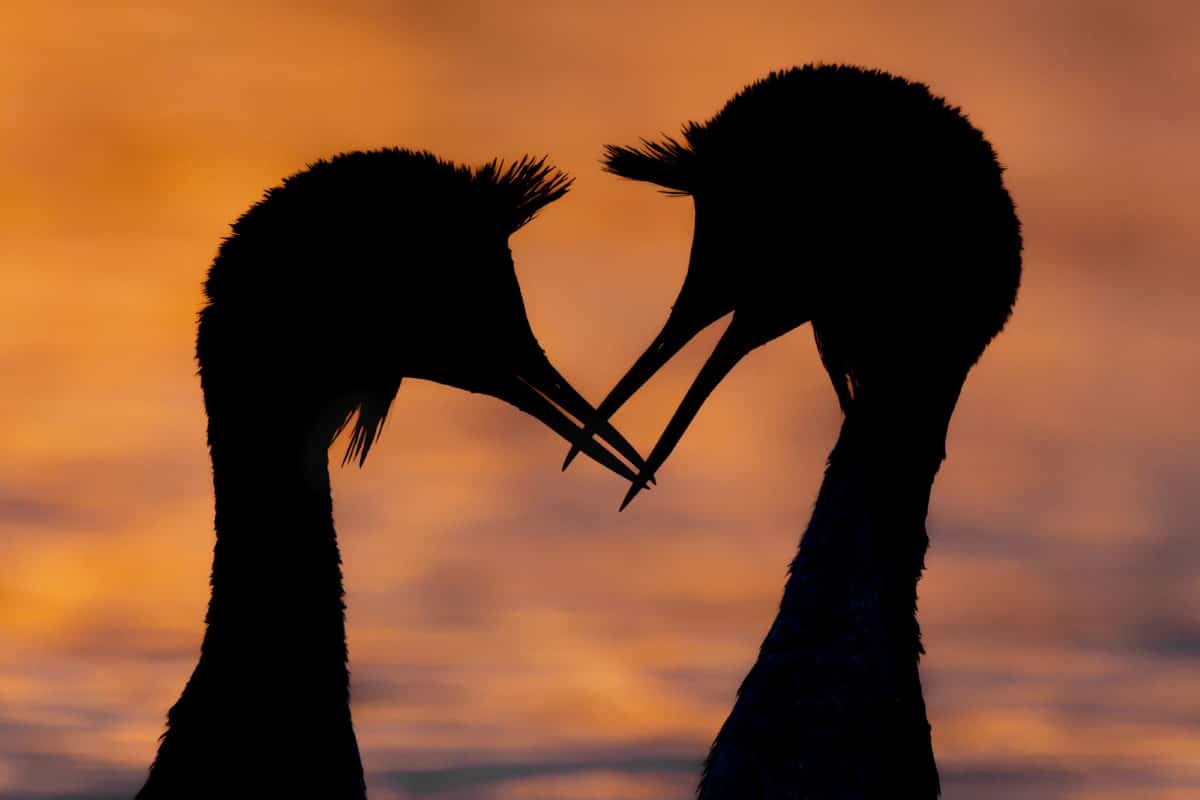
“Dancing in the Dark” by Matthew Glover. Runner-up, Animal Behaviour
Species: Great crested grebe (Podiceps cristatus) Location: Killingworth, North Tyneside, England
“‘Dancing in the Dark’ portrays a pair of great crested grebes engaged in their courtship ritual at sunrise. This carefully choreographed dance serves to strengthen their bonds during the mating season. The photo was captured in the early hours on an urban lake in North Tyneside – once a former mining site, now thriving with wildlife, it hosts up to four separate pairs of grebes, competing for territory and displaying their flamboyant courtship style. Spending considerable time with these birds, I’ve learned to anticipate their courtship ‘dances’ and be prepared to capture these beautiful moments.”
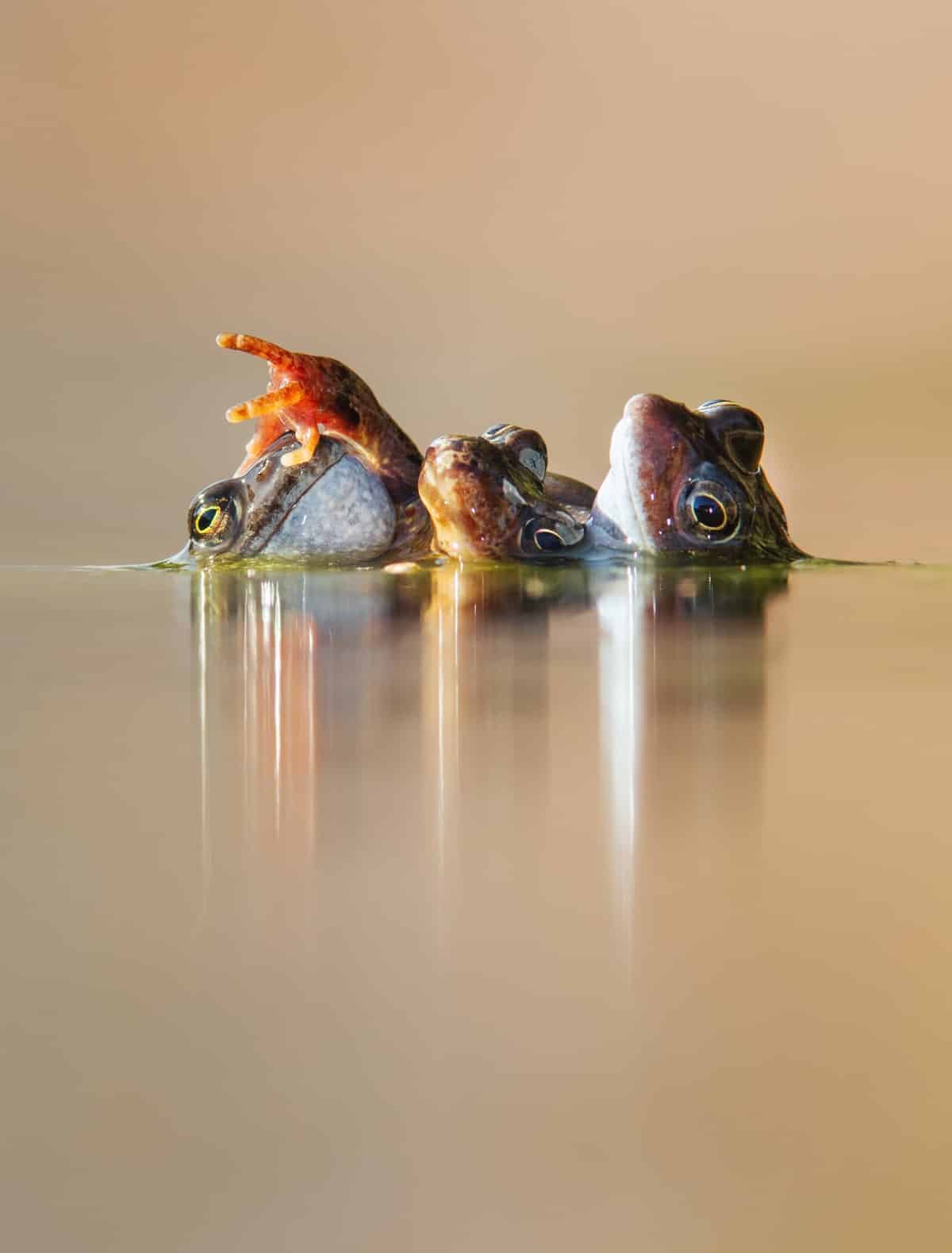
“Three Frogs in Amplexus” by Ian Mason. Winner, Animal Behaviour
Species: Common frog (Rana temporaria) Location: Perthshire, Scotland
“Every March, our garden ponds suddenly come alive with hundreds of frogs that seem to appear overnight from nowhere. I have been photographing them for many years, and I am always fascinated and amused by their antics. Here, there has been a competition to mate with a female. For a lot of the time there is a frenzy of activity, but sometimes they freeze long enough to get a shot. The image is taken with the lens at water level, and the background is a distant larch tree.”
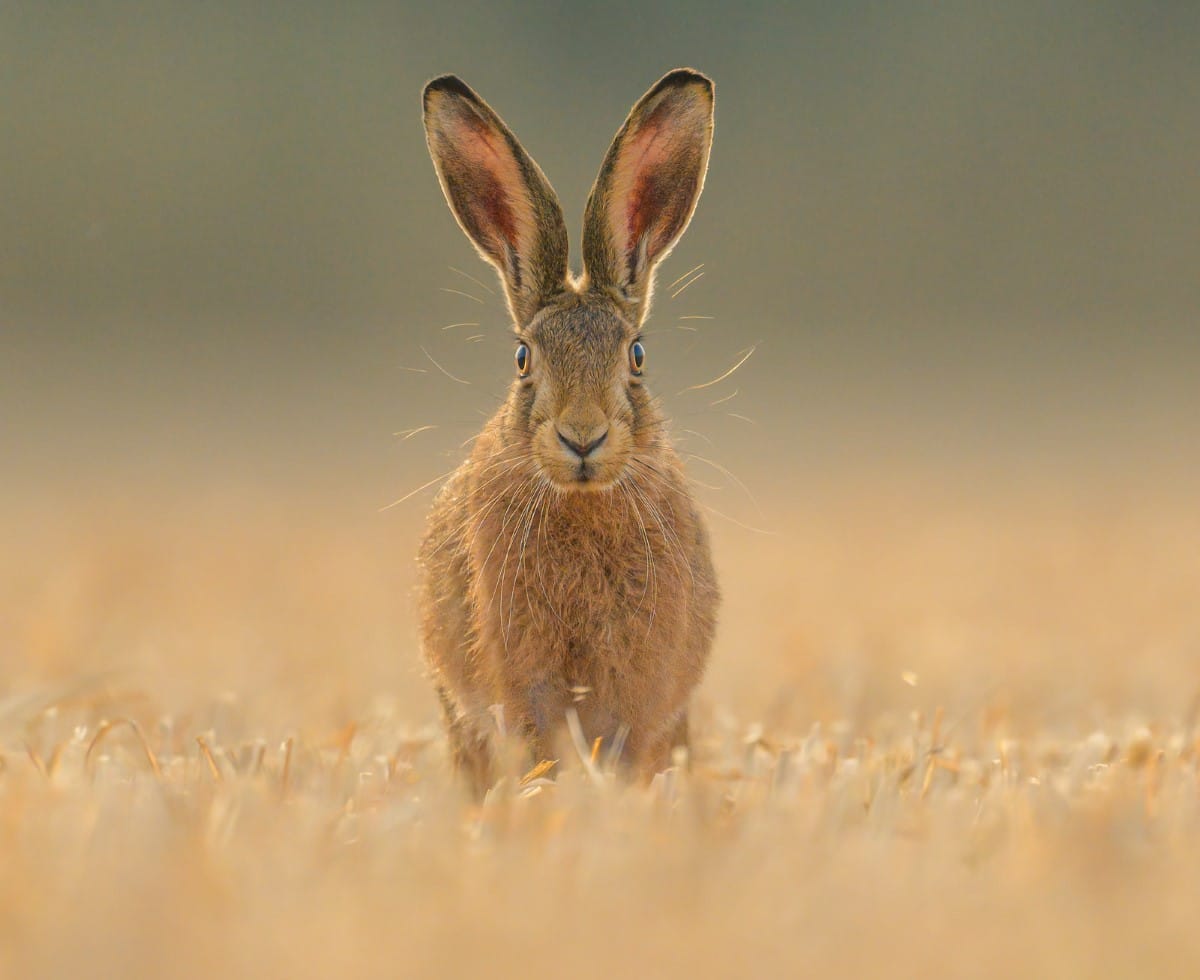
“Sunrise Hare” by Spencer Burrows. Runner-up, Animal Portraits
Species: Brown hare (Lepus europaeus) Location: Nottinghamshire, England
“I’m fortunate enough to have access to a private farm and have spent a lot of time with brown hares over the past couple of years. During this time, I’ve invested many hours into developing fieldcraft and gaining a good understanding of their behavior, allowing me to get close without disturbing the animal – hares are often skittish. For this image, I lay low and silent in a spot of the field they tend to follow from the hedgerow. This hare was very relaxed and allowed me to capture some portraits as the sun was starting to rise over the field.”
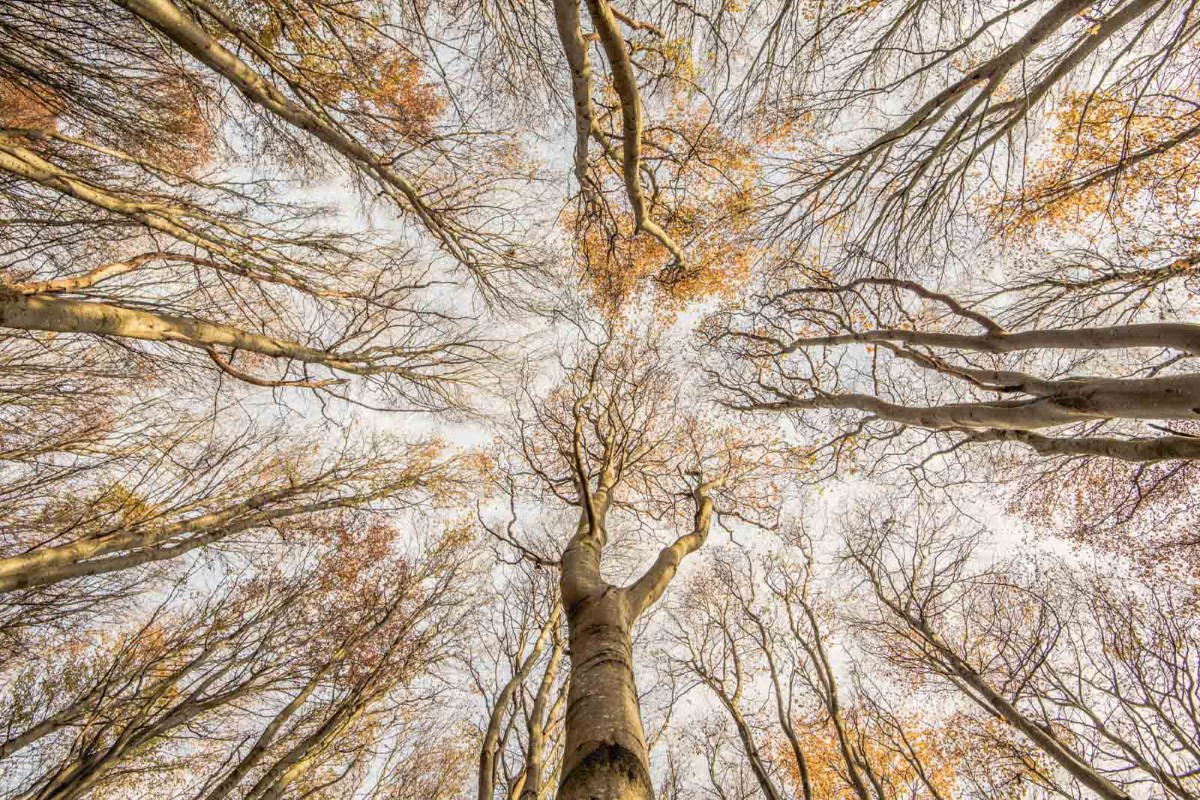
“Beech for the Sky” by Graham Niven. Winner, Wild Woods
Species: Beech (Fagus sylvatica) Location: East Lothian, Scotland
“Beech tree grove near Dunbar in East Lothian. When the leaves are almost gone, the branches show their ‘canopy shyness’ – a phenomenon observed in many species of trees in which the crowns of mature trees do not touch each other. In doing so, the trees form a canopy that has channel-like gaps which, when photographed from below, appear to create an intricate network of channels between the respective canopies. Besides the wondrous vision you are afforded, it’s also just a great excuse to lie down in the forest.”
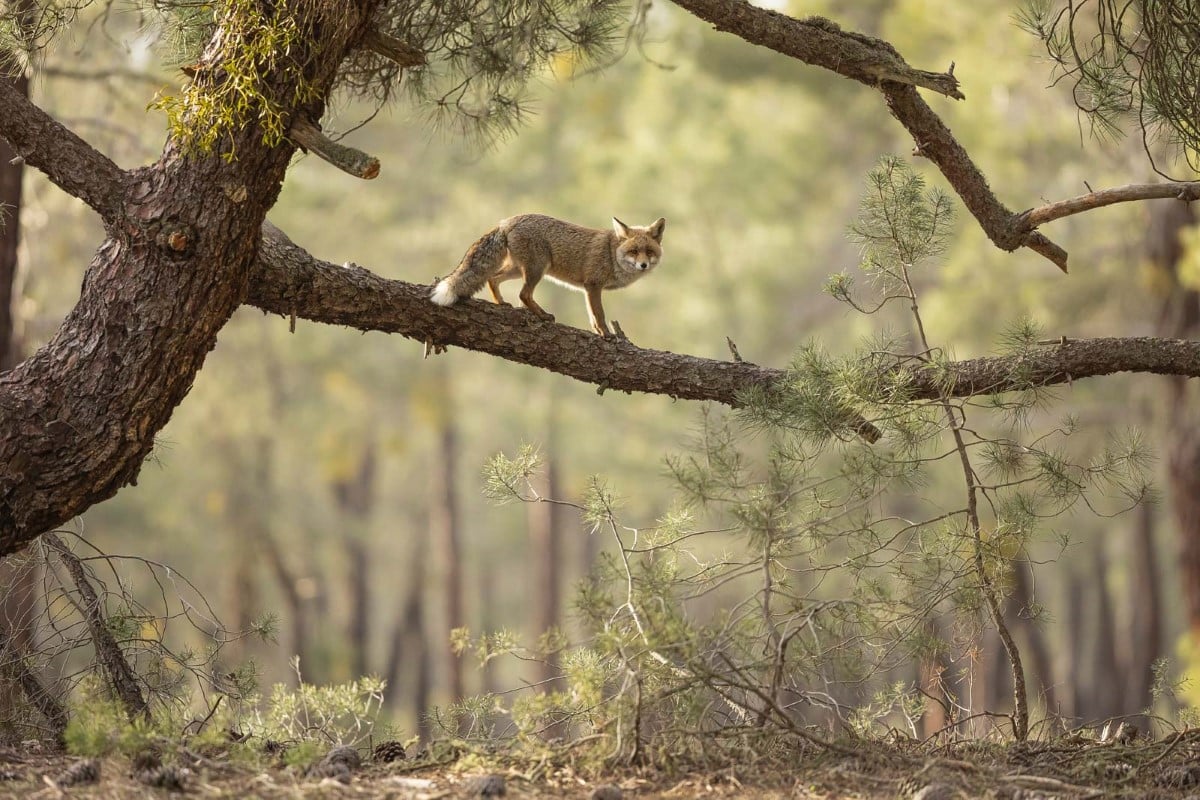
“The Tightrope Walker” by Daniel Valverde Fernandez. Winner, Habitat
Species: Red fox (Vulpes vulpes) Location: Sherwood Pines Forest Park, Nottinghamshire, England
“In this image, you can see a red fox walking along a tree branch at a considerable height from the ground, demonstrating that these animals are true tightrope walkers of nature. The fox is perfectly framed between the branches and its silhouette is subtly highlighted by the sun’s rays falling on it.”
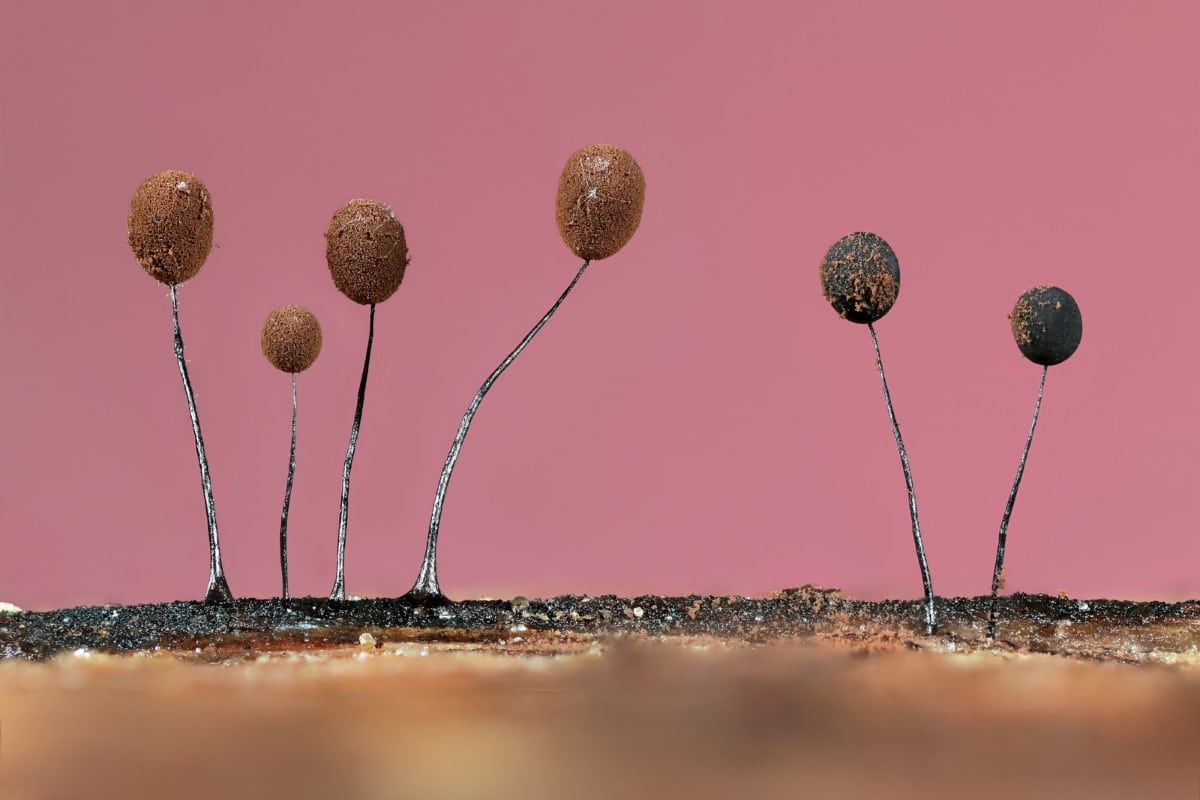
“Tiny Forest Balloons” by Jason McCombe. Winner, Botanical Britain
Species: Slime mold (Comatricha nigra) Location: Essex, England
“The world of slime molds is fascinating. They’re neither plants nor fungi. I had never noticed them before, but when I set out to find some to photograph, I discovered that, if conditions are right, they’re everywhere! They’re just so small that if you are not looking for them you will simply overlook them. Each head on these fruiting bodies is approximately 1mm wide, and the depth of field when shooting at such high magnification is so shallow that focus stacking is required. This image was made using 160 images, each focused on a different area of the scene, then stacked together to create one highly detailed image.”
The contest received over 14,000 images of Britain's natural environment.
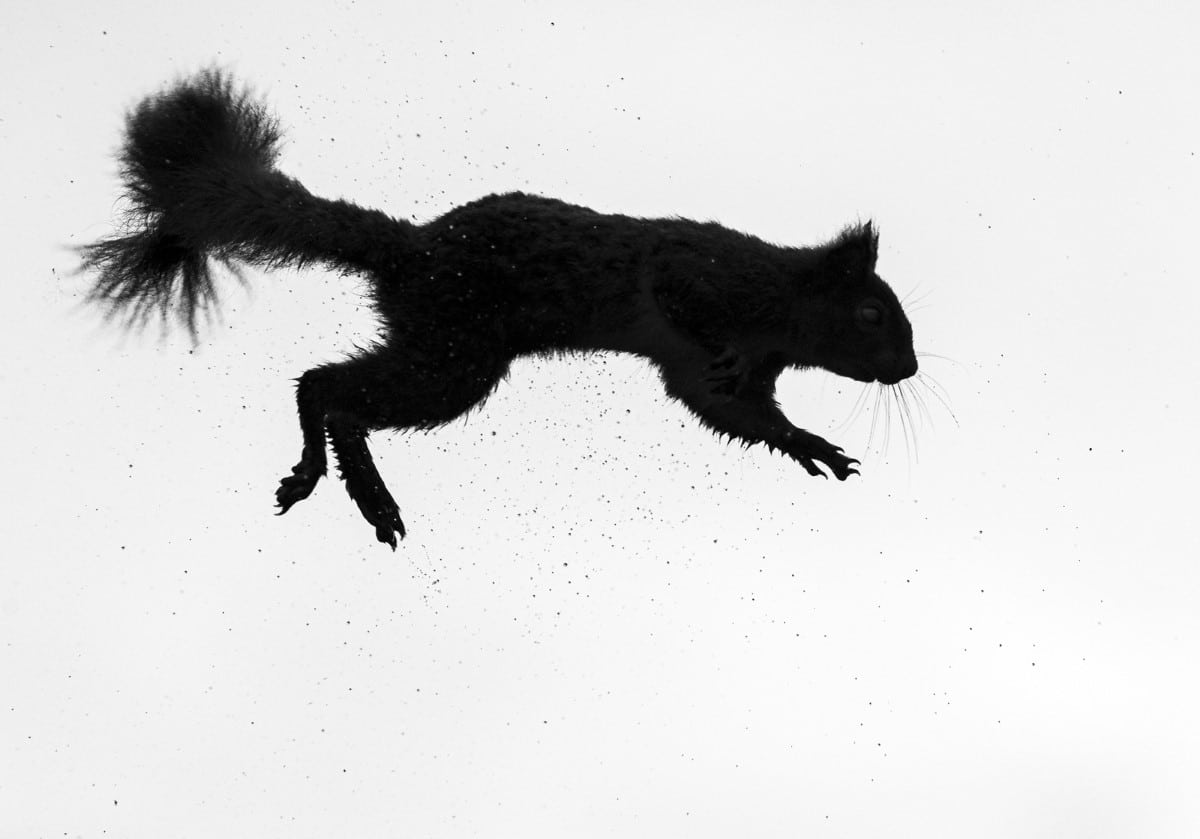
“Squirrel Silhouette” by Rosamund Macfarlane. Runner-up, Black & White
Species: Red squirrel (Sciurus vulgaris) Location: Cumbria, England
“Red squirrels are native and cherished in Cumbria, although they face competition and disease from grey squirrels. These charming creatures visit our garden daily for hazelnuts, and I can capture their antics without causing disturbance. During winter, when food is scarce, providing for them feels like helping our native population. This spring, young kits joined the adults for breakfast, and capturing their dynamic movements against the sky was a fascinating challenge.”
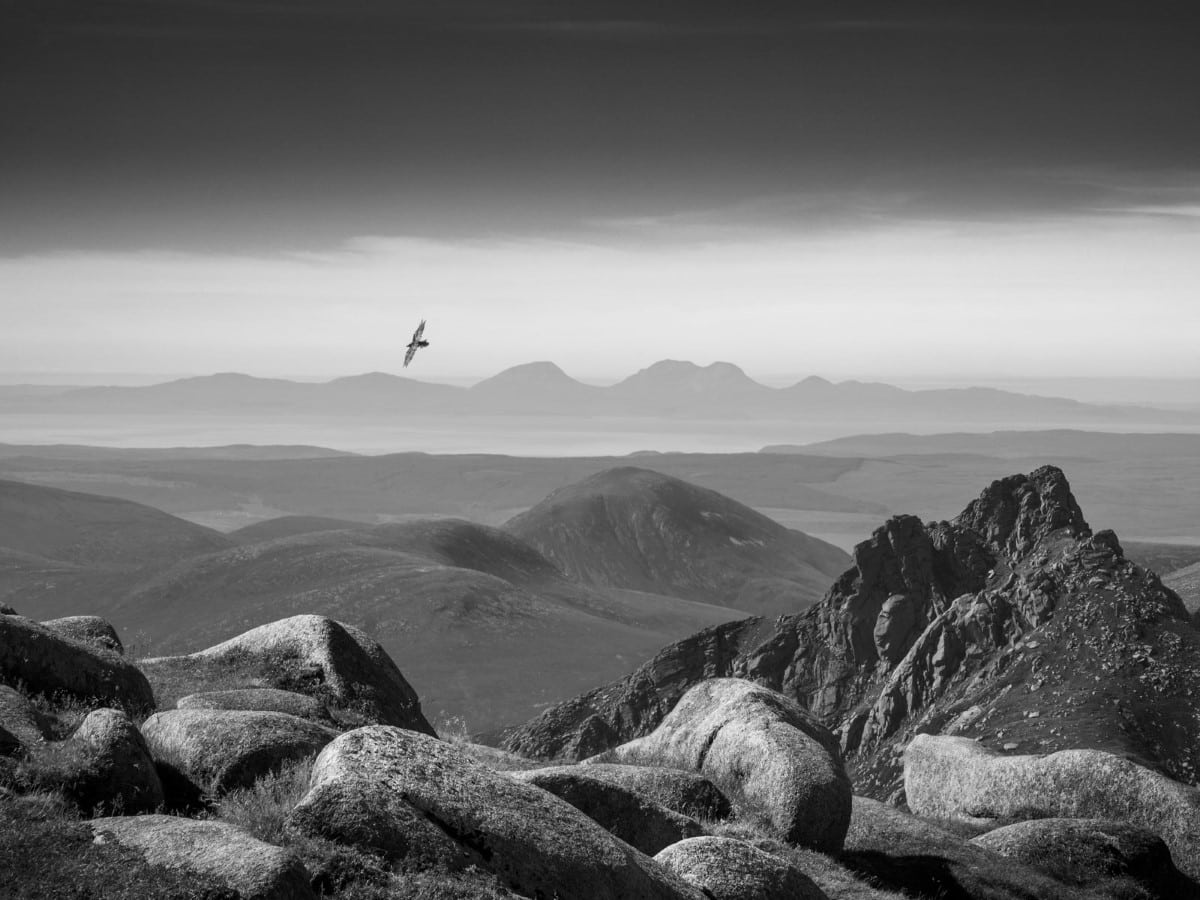
“Raven Above Arran” by Robin Dodd. Winner, Black & White
Species: Raven (Corvus corax) Location: Isle of Arran, Scotland
“This is a shot from the top of Goatfell on the Isle of Arran, which is the highest mountain on the island. It was a lovely hike to the top on a bright summer afternoon after arriving by ferry a few hours before. When we reached the summit, it was deserted except for two ravens who seemed to dominate the peak. We sat for some time, observing these birds gliding over Arran just as gracefully as any bird of prey. It’s a harsh yet beautiful world they inhabit. This image is in black and white and consists of two shots, focus stacked.”
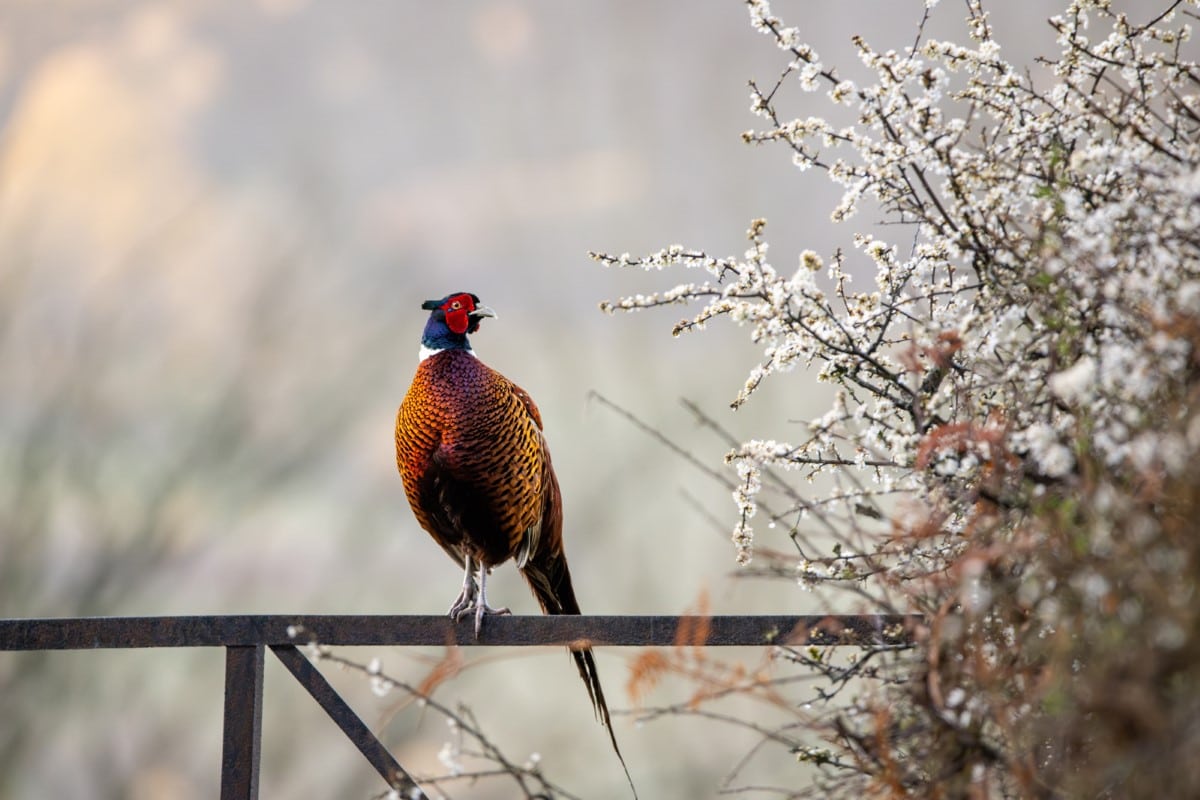
“Spring’s Treasures” by Jamie Smart. Winner, 11 and under
Species: Pheasant (Phasianus colchicus) Location: Mid Wales
“We got up very, very early one cold (-5°C), misty morning in spring in an effort to try to find some boxing hares up on the moorland. On our way there, I spotted this pheasant sitting on a farm gate in the morning sunrise. I made Dad stop the car and reverse slowly, quietly opened my car window, and managed to get this photo of him in all his beauty, with the blackthorn blossom behind him and the sun rays lighting up his copper breast feathers. As it happens, we didn’t get to see any hares boxing that morning, but Mr. Pheasant making this appearance really made up for it!”
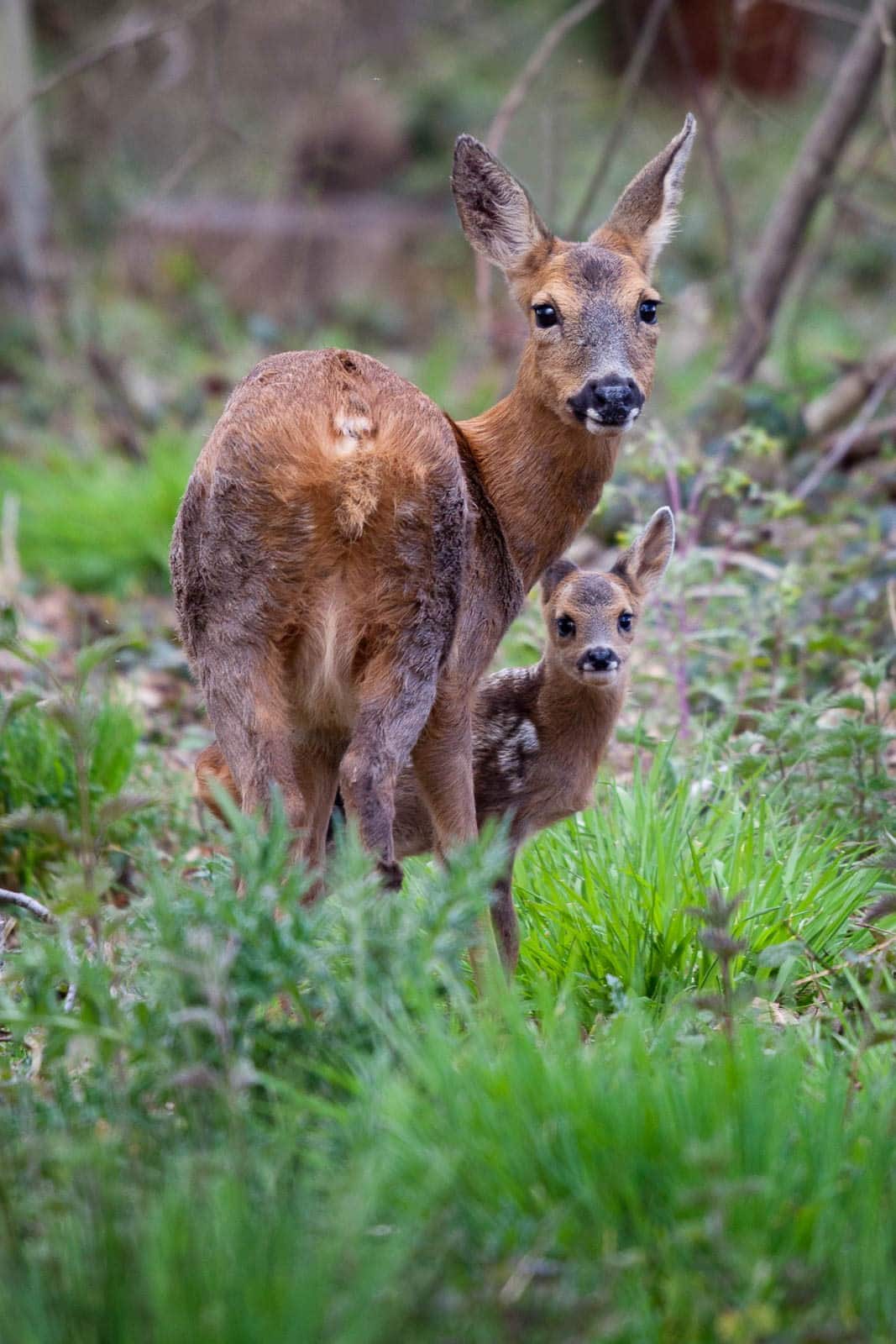
“Mother and Fawn” by Felix Walker-Nix. Winner, 12-14 years
Species: Roe deer (Capreolus capreolus) Location: Sherfield on Loddon, England
“Walking through the woods, I spotted this roe doe grazing the foliage. Slowly, I crept towards her, careful not to startle her. To my delight, when she turned around, I saw a small fawn staring back at me! Keeping quiet, I raised the camera to take some photos, then swiftly left so I didn’t disturb the young fawn and mother any longer. It was an incredible experience to see a ‘humbug’ patterned fawn before it lost its spots, and it was a magical experience to get so close.”
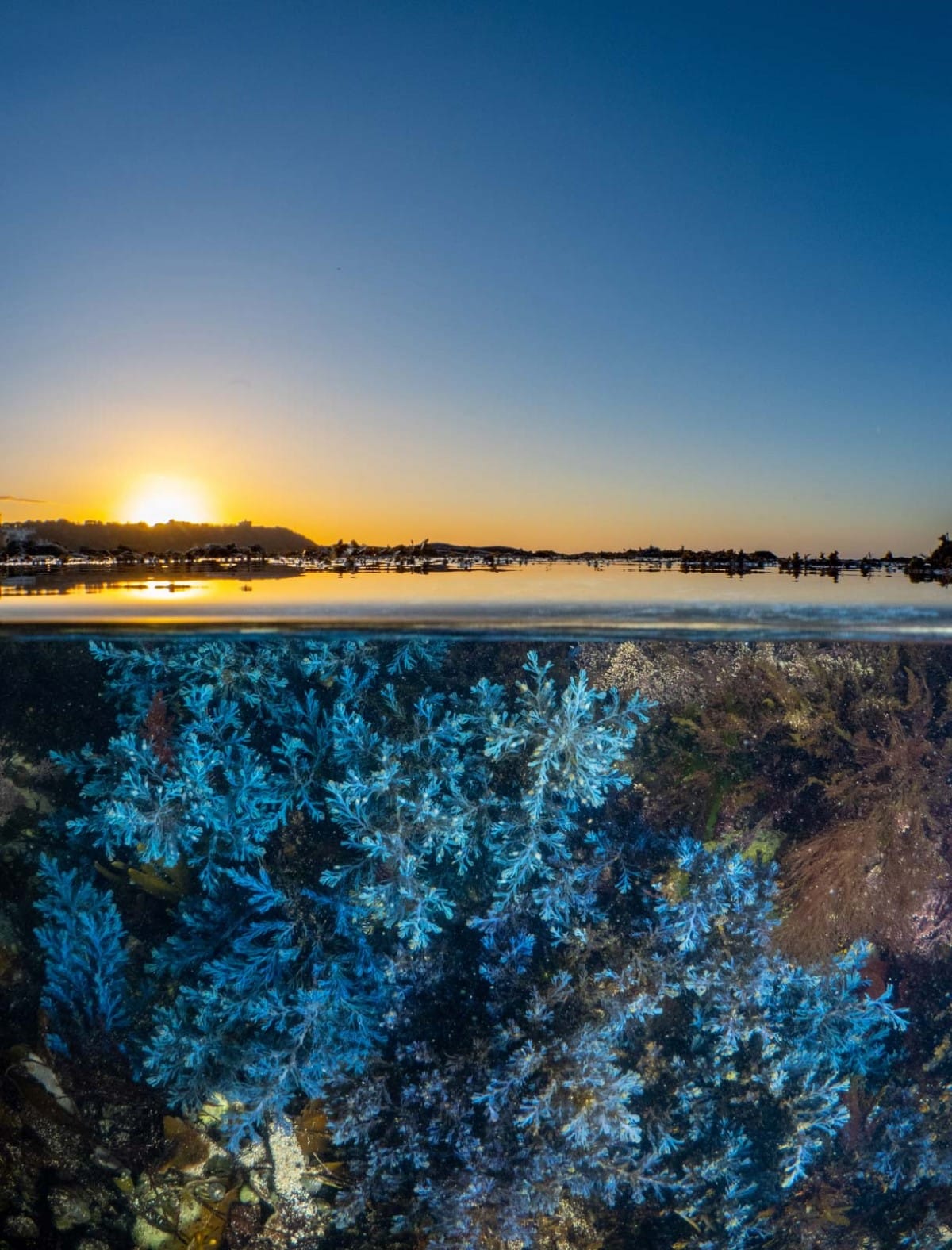
“Rainbow at Dawn” by Martin Stevens. Runner-up, Botanical Britain
Species: Rainbow wrack (Cystoseira tamariscifolia) Location: Falmouth, Cornwall, England
“I’ve had a mild obsession with rainbow wrack seaweed for years, with its spectacular iridescent blue color. I’d taken many photos of it before, but I had long had in mind a split shot of it in a rock pool at sunrise. It required planning and luck because the seaweed only grows back in spring, being most colorful for a few weeks before the summer sun dulls its color. I needed a low tide to expose the pools, in sync with sunrise – and a sunny morning! Fortunately, on one day it all came together. Taken with strobes on low power to light the seaweed.”
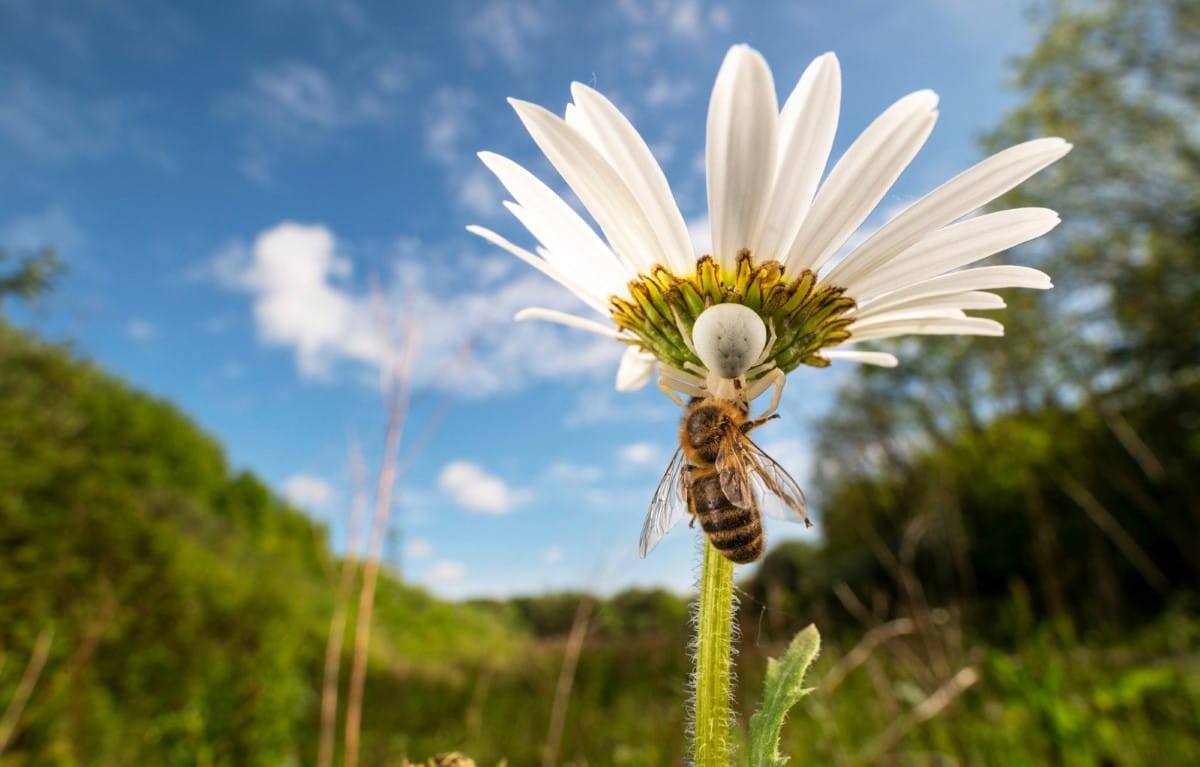
“Daisy Danger” by Lucien Harris. Runner-up, Hidden Britain
Species: Flower crab spider (Misumena vatia) and Honey bee (Apis mellifera) Location: Lee Mill, Devon, England
“This photo was taken in a patch of land along the A30 in Devon that has been left untouched for a long time, making it a haven for wildflowers and the wildlife that inhabits it. Using the Laowa wide-angle macro lens, I aimed to capture this scene. While walking, I came across a flower crab spider wrestling with a bee on an ox-eye daisy. The light was behind the subject, which backlit the flower nicely. However, the spider itself was quite dark, so I used some flashes and homemade flash diffusers to illuminate it. This allowed me to capture the deadly strength of these ambush predators.“
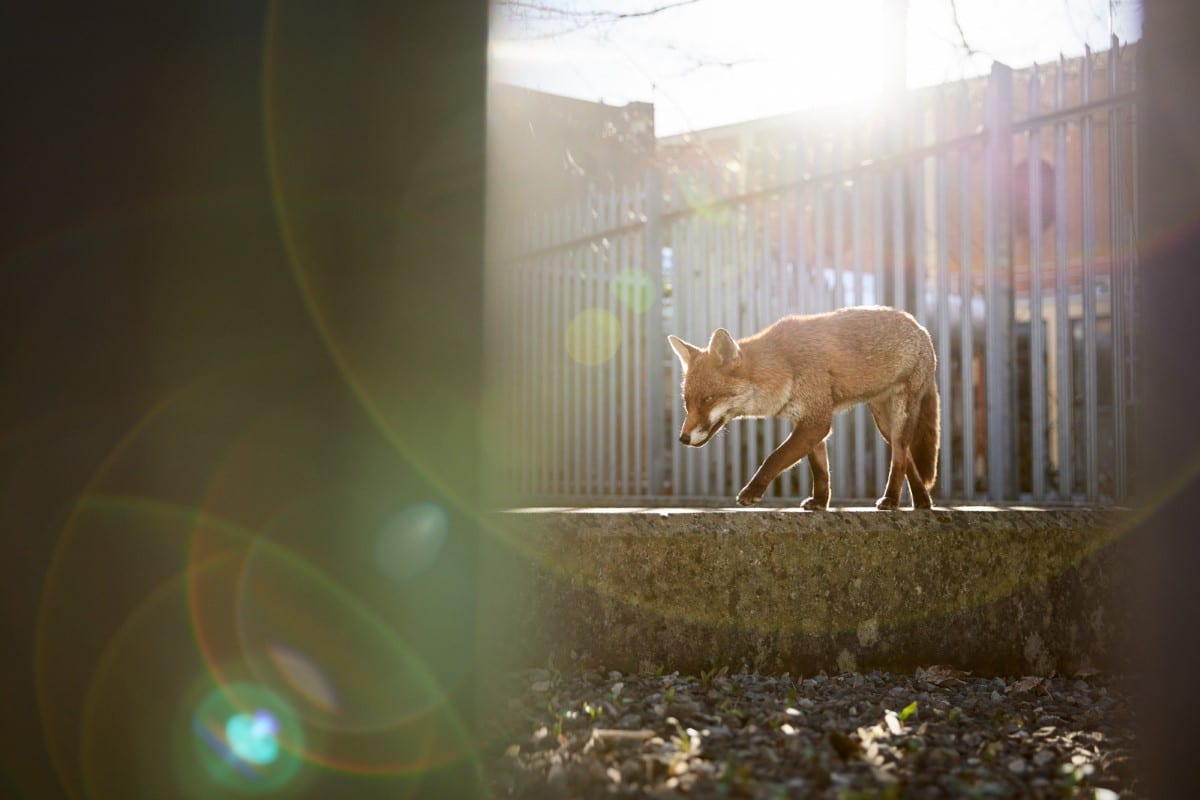
“Day Walker” by Simon Withyman. Winner, Urban Wildlife
Species: Red fox (Vulpes vulpes) Location: Bristol, England
“This vixen had taken up residence in an electricity substation after being pushed out of her parental territory. The fenced-off area provided her with a quiet place to rest away from the busy city. She would often walk along this wall, and I was able to capture this photo through the gaps in the metal fencing, while making the most of some striking lens flare.”
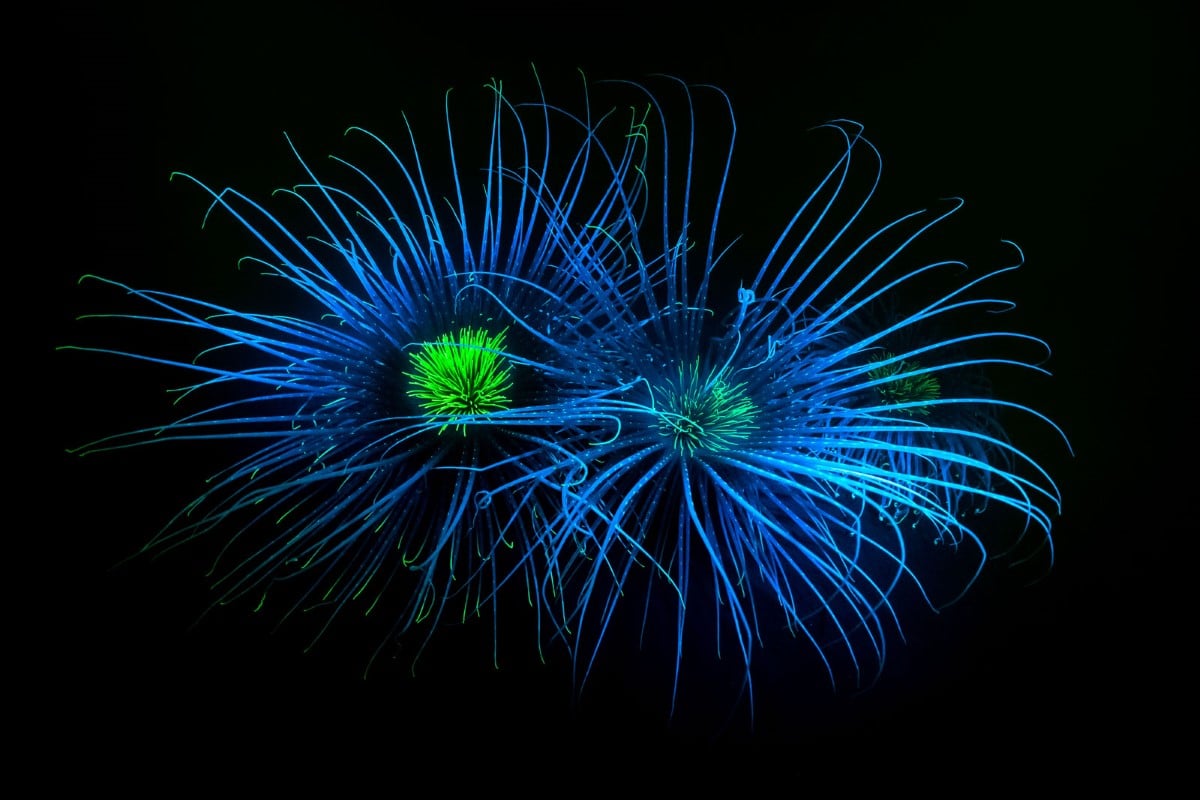
“Fire in the Night” by Dan Bolt. Runner-up, Coast & Marine
Species: Fireworks anemone (Pachycerianthus multiplicatus) Location: Loch Fyne, Scotland
“Fluorescence photography requires specialist filters: one ‘exciter’ filter on your white-light source to create the blue light and another ‘barrier’ filter in front of your lens to reduce the ambient light reaching your sensor. These dual filters mean that high ISOs and open apertures are very much required in order to capture the excited, or fluoresced, light. The subject requires a careful approach too; these anemones live in very still water and are sensitive to the slightest movement. If disturbed, they will retract in mere seconds.”
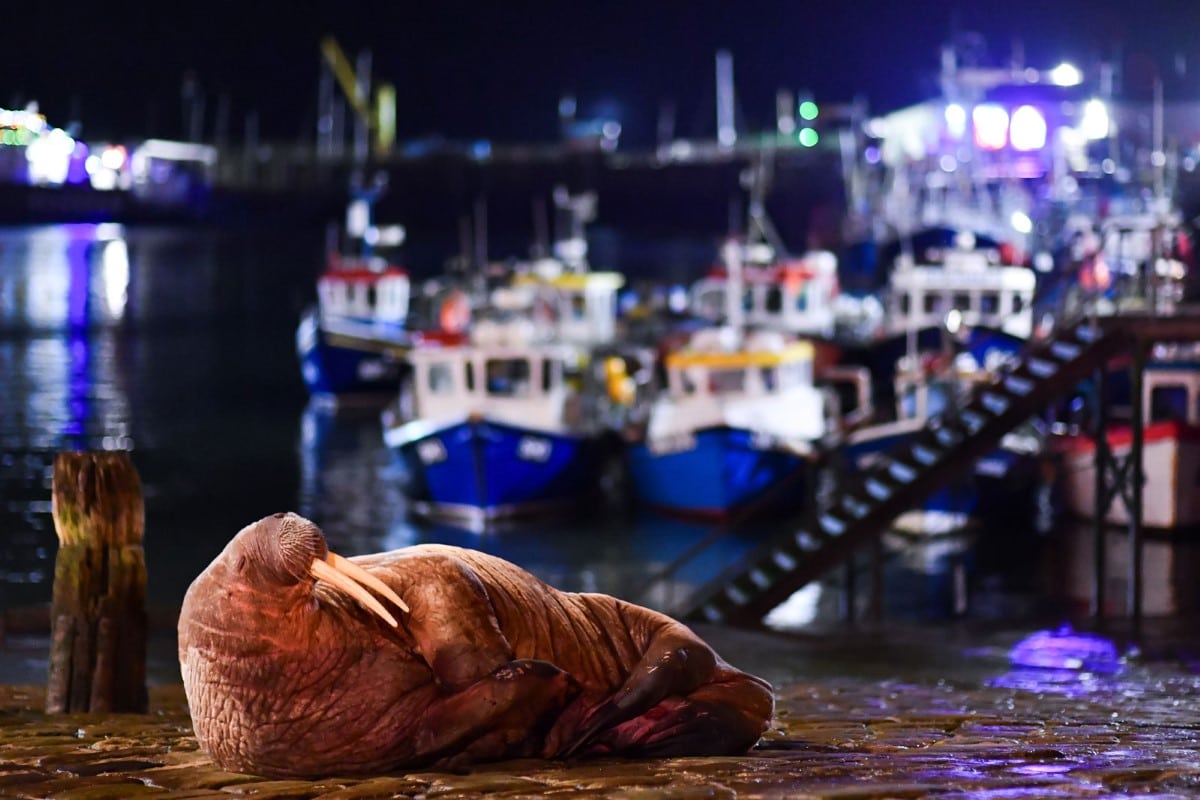
“What’s All the Fuss About?” by Will Palmer. Runner-up, Urban Wildlife
Species: Walrus (Odobenus rosmarus) Location: Scarborough, North Yorkshire, England
“In this photograph, the Arctic walrus who had come ashore to rest on the harbor slipway in Scarborough has lifted its head as a car passed on Foreshore Road. The image is lit by the streetlights to the left and features the town’s fishing boats in the background. Despite being taken handheld at 1/80th of a second at f/1.6, an ISO of 6400 was still needed to properly expose Thor and the slipway at 2:28 am.”

“Into the Mist” by Philip Selby. Runner-up, Wild Woods
Species: Beech (Fagus sylvatica) Location: Badbury Hill, Oxfordshire, England
“On the remains of an Iron Age hill fort on Badbury Hill in Oxfordshire, Badbury Clump is an area of wonderful beech woodland, carpeted in bluebells each spring. Like most photographers during those precious few weeks of spring, it’s a time of anxious weather forecast watching, hoping that atmospheric weather conditions and schedules align. Luckily, the woodland was shrouded in dense fog on this particular morning, and the vibrant new beech leaves and subtle hues of the bluebells added a contrasting splash of color to the otherwise monochromatic scene.”











































































